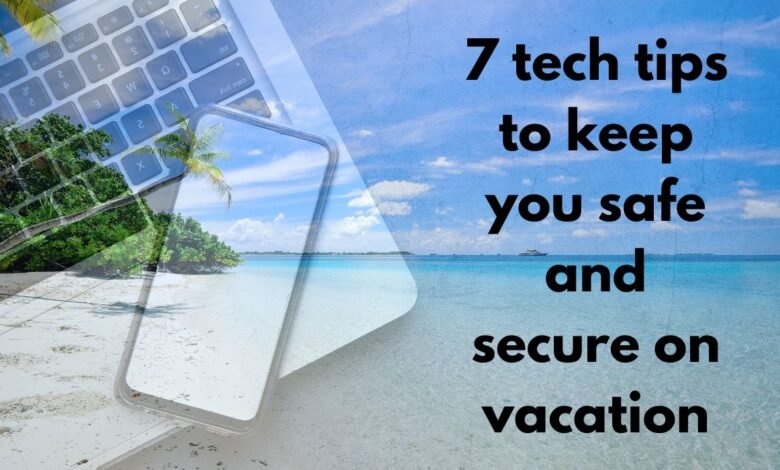7 tech tips to keep you safe and secure on vacation
Bon voyage without worries! Our 7 tech tips safeguard your data & devices from online threats while you travel.

Vacation carefree! These 7 tech tips lock down your data & protect you from online threats while traveling.
When you’re traveling, especially in locations offering free public Wi-Fi, your data could be at significant risk. Hackers often exploit unsecured networks to access personal information such as passwords, credit card details, and private communications. One of the most effective ways to safeguard your internet browsing is by using a Virtual Private Network (VPN).
A VPN works by creating a secure, encrypted connection between your device and the internet, making your online activities unreadable to anyone who might intercept them. This guide will explore essential tips for maintaining digital security while traveling, starting with the importance of using a VPN.
Tip 1: Use Virtual Private Network
When you’re traveling, especially in locations offering free public Wi-Fi, your data could be at significant risk. Hackers often exploit unsecured networks to access personal information such as passwords, credit card details, and private communications. One of the most effective ways to safeguard your internet browsing is by using a Virtual Private Network (VPN).
A VPN works by creating a secure, encrypted connection between your device and the internet. This encrypted tunnel ensures that all data transmitted between your device and the VPN server is unreadable to anyone who might intercept it. Essentially, a VPN disguises your IP address and encrypts your online activities, making it extremely difficult for hackers to access your information.
The importance of using a VPN while traveling cannot be overstated. Not only does it protect your sensitive data from cybercriminals, but it also allows you to access content that might be restricted in certain regions. For instance, some countries impose stringent internet censorship, limiting access to social media, news websites, and other online services. A VPN enables you to bypass these restrictions by masking your actual location, granting you unrestricted access to the internet.
When selecting a VPN service, it’s essential to choose one that is reliable, user-friendly, and offers robust security features. Some recommended VPN services include NordVPN, ExpressVPN, and CyberGhost. These providers are well-regarded for their high encryption standards, no-logs policies, and extensive server networks, ensuring fast and secure connections worldwide.
Using a VPN is a critical step to ensure secure internet browsing while on vacation. By encrypting your connection and safeguarding your personal information, a VPN provides peace of mind, allowing you to enjoy your travels without worrying about cyber threats.
Tip 2: Enable Two-Factor Authentication (2FA)
Two-Factor Authentication (2FA) is a crucial security measure that significantly enhances the protection of your online accounts, particularly when you are on vacation. By requiring a second form of verification in addition to your password, 2FA ensures that even if your password is compromised, unauthorized access to your accounts remains challenging. This second layer of security can take various forms, such as a text message code, an email, or a biometric scan like a fingerprint or facial recognition.
Implementing 2FA is straightforward and can be accomplished on most major platforms. For instance, on Google accounts, you can enable 2FA by going to your account settings, selecting ‘Security,’ and then following the prompts under ‘2-Step Verification.’ Similarly, for Apple IDs, navigate to ‘Settings,’ click on your name, then ‘Password & Security,’ and finally, ‘Turn on Two-Factor Authentication.’
Social media platforms like Facebook and Twitter also offer 2FA. On Facebook, go to ‘Settings & Privacy,’ then ‘Security and Login,’ and under ‘Two-Factor Authentication,’ choose your preferred verification method. On Twitter, access ‘Settings and Privacy,’ select ‘Security and account access,’ and enable ‘Two-Factor Authentication.’
The benefits of 2FA are substantial, especially when you are traveling and might be using unsecured networks. By requiring a second form of verification, 2FA adds an additional barrier for cybercriminals attempting to access your sensitive information. This is particularly crucial when accessing financial accounts, email, and social media profiles that could contain personal data.
Moreover, 2FA helps protect against phishing attacks, where malicious actors attempt to deceive you into providing your login credentials. Even if you inadvertently disclose your password, the additional verification step renders it virtually useless to the attacker.
Enabling Two-Factor Authentication is a simple yet highly effective strategy to bolster your online security while on vacation. By taking a few minutes to set it up across your various accounts, you can enjoy your travels with greater peace of mind, knowing that your sensitive information is well-protected.
Tip 3: Keep Your Devices Updated
One of the most effective measures you can take to safeguard your digital safety during vacation is ensuring all your devices are up-to-date. Software updates frequently contain crucial security patches that address vulnerabilities, protecting your smartphone, tablet, and laptop from potential threats. Neglecting these updates can leave your devices susceptible to cyber attacks, malware, and other security risks.
Before embarking on your trip, it is essential to perform a thorough check for any available updates. For smartphones and tablets, navigate to the settings menu, usually found under “General” or “System.” From there, locate the “Software Update” section, which will inform you if any updates are available. If so, follow the on-screen prompts to download and install the updates. For laptops, the process is somewhat similar. On Windows devices, go to “Settings,” then “Update & Security,” and click on “Check for updates.” For Mac users, open the “System Preferences” application and select “Software Update.”
Moreover, it’s prudent to configure your devices to update automatically. This ensures that your devices stay protected with the latest security enhancements, even if you forget to check for updates manually. On most smartphones and tablets, the option to enable automatic updates can be found in the same “Software Update” menu. For laptops, Windows users can enable automatic updates in the “Update & Security” settings, while Mac users can do so in the “Software Update” section under “System Preferences.”
Updating your devices is not a one-time task but an ongoing process. During your vacation, make it a habit to periodically check for updates, especially if you plan to use public Wi-Fi or other shared networks. This proactive approach will significantly reduce the risk of encountering security issues and ensure a worry-free travel experience.
Tip 4: Backup Your Data Regularly
Losing your device or having it stolen while on vacation can be distressing, especially if it contains critical information or irreplaceable memories. Regular data backups are essential to mitigate the risk of permanent data loss. In today’s digital age, there are several reliable methods to back up your data, ensuring your vital information remains secure and accessible.
One of the most convenient and efficient ways to back up your data is through cloud services. Providers like Google Drive, Dropbox, and iCloud offer seamless synchronization of your files across multiple devices. By leveraging cloud storage, you can effortlessly access your data from anywhere with an internet connection. Moreover, most cloud services offer automatic backup features, reducing the manual effort required and minimizing the risk of forgetting to back up important files.
Another effective method is using external storage devices, such as portable hard drives or USB flash drives. These devices provide a physical backup of your data, which can be crucial if you are in areas with limited internet access. To ensure data integrity, it is advisable to use high-quality, reliable storage devices and to keep multiple copies in different locations. Regularly updating these backups can provide an extra layer of security.
Setting up automatic backups is a practical step to ensure your data is consistently protected. Most modern operating systems, including Windows and macOS, offer built-in backup solutions like File History and Time Machine, respectively. These tools can be configured to run automatic backups at regular intervals, safeguarding your data without requiring constant oversight.
Maintaining data integrity is equally important. Regularly checking your backup files for any corruption or errors can prevent unpleasant surprises when you need to restore your data. Additionally, encrypting your backups adds an extra layer of security, protecting your information from unauthorized access.
Incorporating these backup strategies into your routine not only ensures the safety of your data but also provides peace of mind while you enjoy your vacation. By taking proactive measures, you can focus on creating new memories, knowing that your valuable data is secure.
Tip 5: Use Strong, Unique Passwords
Ensuring your digital safety while on vacation starts with using strong, unique passwords. A strong password is your first line of defense against unauthorized access to your online accounts. Characteristics of a robust password include a mix of upper and lower case letters, numbers, and special characters. Ideally, a strong password should be at least 12 characters long and shouldn’t include easily guessable information like names, birthdates, or common words.
Using the same password across multiple accounts significantly increases your risk. If one account gets compromised, cybercriminals can potentially access all your other accounts. Therefore, it is crucial to use different passwords for different accounts, enhancing your overall security posture.
Managing multiple complex passwords can be challenging, but password managers offer a practical solution. These tools generate, store, and manage your unique passwords securely, ensuring you only need to remember one master password. Popular password managers such as LastPass, Dashlane, and 1Password provide robust features like automatic password generation, secure storage, and autofill capabilities. LastPass, for instance, boasts a user-friendly interface and a comprehensive free tier, while Dashlane offers advanced security features and a VPN service. 1Password, on the other hand, is known for its high-level encryption and seamless integration across various devices.
By incorporating a password manager into your digital routine, you significantly reduce the likelihood of unauthorized access. These tools not only enhance security but also streamline the process of managing multiple accounts, making it easier to maintain strong, unique passwords for each one. Implementing these practices is an essential step in safeguarding your personal information, particularly when you are away from home and potentially more vulnerable to cyber threats.
Tip 6: Be Wary of Phishing Scams
Phishing scams are a prevalent threat, especially during vacation periods when individuals may be less vigilant. These scams often manifest as emails, messages, or even phone calls that appear to be from trusted sources but are designed to trick you into divulging personal information. Key indicators of phishing attempts include unexpected communications, requests for sensitive data, and messages containing urgent language or threats.
One common sign of a phishing email is a mismatched or suspicious sender address. Scammers often use email addresses that closely resemble legitimate ones but may have slight variations. Additionally, phishing messages frequently contain grammatical errors, awkward phrasing, or generic greetings like “Dear Customer” instead of using your name. Be particularly cautious of any unsolicited messages that ask you to click on a link or download an attachment, as these can install malware on your device.
To recognize and avoid phishing scams, always verify the sender’s identity before responding to any request for personal information. If an email or message seems suspicious, do not click on any links or provide any information. Instead, contact the organization directly using a verified phone number or website. It’s also wise to enable two-factor authentication (2FA) on your accounts, as this adds an additional layer of security.
If you suspect that you have been targeted by a phishing scam, act promptly. Change your passwords immediately, especially for any accounts that may have been compromised. Monitor your financial statements and credit reports for any unusual activity. Reporting the phishing attempt to the appropriate authorities, such as your email provider or the Federal Trade Commission (FTC), can also help to mitigate the risk and potentially prevent future incidents.
By staying vigilant and following these practical steps, you can significantly reduce the likelihood of falling victim to phishing scams while enjoying your vacation. Remember, a cautious approach to digital communications is essential for maintaining your personal security.
Tip 7: Secure Your Physical Devices
While digital security measures are essential, the physical security of your devices should not be overlooked. Ensuring that your smartphones, tablets, and laptops are physically secure can prevent unauthorized access and potential theft. One of the primary steps in securing your devices is to use lock screens. Most modern devices offer various lock screen options, including PIN codes, passwords, fingerprint recognition, and facial recognition. These features act as the first line of defense against unauthorized access.
Another effective method to bolster the security of your physical devices is by using tracking apps. Many devices come with built-in tracking features, such as Apple’s Find My iPhone or Google’s Find My Device. These apps allow you to locate your device if it is lost or stolen, and in some cases, you can remotely lock or wipe the device to protect your sensitive data. Installing and enabling these tracking features before you go on vacation can provide peace of mind and an added layer of security.
Secure storage options are also crucial when it comes to protecting your devices. When staying in hotels or other accommodations, make use of in-room safes to store your devices when they are not in use. If a safe is not available, consider portable security options such as lockable bags or laptop locks. These tools can deter theft and safeguard your devices from opportunistic criminals.
Additionally, being vigilant in public spaces is vital. Avoid leaving your devices unattended, even for a short period. Public areas such as cafes, airports, and tourist attractions can be hotspots for theft. Always keep your devices within sight and consider using anti-theft backpacks or bags with hidden compartments to make it harder for thieves to access your belongings.
By implementing these physical security measures, you can significantly reduce the risk of losing your devices or having them compromised while on vacation. Taking proactive steps to secure your physical devices will complement your digital security efforts, ensuring a safer and more enjoyable trip.
- Breaking: India’s Q4 GDP at 7.8%, FY24 Growth Reaches 8.2%
- Nuclear Power Market: A Comprehensive $43 Billion Opportunity by 2031
Conclusion: 7 tech tips to keep you safe and secure on vacation
Ensuring your digital security while traveling involves multiple layers of protection. Using a VPN is a critical step to secure your internet browsing and safeguard personal information.
By combining this with enabling two-factor authentication, keeping your devices updated, regularly backing up your data, using strong passwords, being vigilant about phishing scams, and securing your physical devices, you can significantly enhance your safety.
These proactive measures provide peace of mind, allowing you to enjoy your travels without worrying about cyber threats. Stay informed, stay protected, and make the most of your journey.



